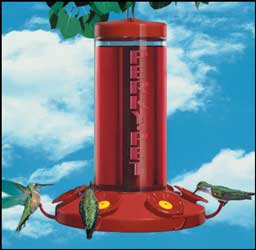Hummingbird Feeders/Attracting Hummingbirds |
 Hummingbirds in the United States feed on flower nectar and many small insects. Your garden should provide a healthy, steady diet of both. hummingbird feeders: Should be hung in the shade if possible and should be cleaned and refilled every three to five days under normal circumstances. Fill your hummingbird feeder with a solution of one part table sugar to four parts water, brought to a boil and then cooled and stored in the refrigerator for future use. Your hummingbird feeder should not be filled with honey solutions, as they may produce a fungal disease fatal to hummingbirds. Spread your hummingbird foods - flowers and feeders - throughout your entire garden to discourage dominance by any one bird. Hummingbird flowers, unlike flowers for butterflies, are attractive to these birds whether in the sun or shade. Hummingbirds in the east usually return in late March (south) to mid-May (north). They usually leave in early September (north) to late November (south). In the Deep South, more and more hummingbirds are overwintering. Hang your feeders accordingly. Pesticides, especially sprays, can be lethal to hummingbirds. Even if they do not take in enough nectar dosed with malathion, Sevin or diazinon to kill them directly, the number of small insects available to them in your garden will drop precipitously. This may cause starvation and/or death of the young. Plants that Provide Nectar for Hummingbirds If hummingbirds live in your area, you can attract them by planting red, tubular flowers. There are many red-flowered plants to choose from. Over 160 native, North American plants depend exclusively on hummingbirds for pollination. Many of the red-flowered annuals, perennials, vines, and shrubs available from mail order sources or local garden centers have been developed from the native red-flowered plants of the western hemisphere. Here is a list of some of the plants that most successfully attract hummingbirds: Trumpet honeysuckle Bee-balm Trumpet-creeper Fire pink Cardinal-flower Scarlet petunia Scarlet penstemon Red buckeye Scarlet morning glory Geiger tree Cypress vine Scarletbush Scarlet paintbrush Coral bells Scarlet salvia. There are dozens of other plants, mostly red and tubular, that also work very well. Try a few new ones each year. Information provided by the National Wildlife Federation Tips for keeping bees away from your Hummingbird Feeder Bees can sometimes be a problem at a hummingbird feeder but bees can be guided to a bowl filled with a 1 to 2 parts sugar/1part water mix. Place a bowl in a location not too far from the hummingbird feeder. If the plate or bowl is yellow that would be even better, because bees are attracted to the color yellow. The bees will, in most cases, move over to the bowl rather than the feeder. Once the bees are attracted to the bowl, move the bowl in a sunny spot a little farther away from the feeder, preferrably at night because there will be less activity. After a few days of moving the bowl, the bowl will be far enough away to allow hummingbirds to feed on their feeder rather than the bees. The bees will be at the decoy bowl. Attracting hummingbirds to your backyard |
 |